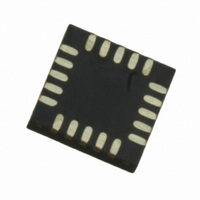MPR121QR2 Freescale Semiconductor, MPR121QR2 Datasheet - Page 47

MPR121QR2
Manufacturer Part Number
MPR121QR2
Description
IC CTLR TOUCH SENSOR 20-QFN
Manufacturer
Freescale Semiconductor
Type
Capacitive, Proximity Sensorr
Datasheet
1.MPR121QR2.pdf
(57 pages)
Specifications of MPR121QR2
Number Of Inputs/keys
12 Key
Data Interface
I²C, Serial
Voltage - Supply
1.71 V ~ 3.6 V
Current - Supply
29µA
Operating Temperature
-40°C ~ 85°C
Mounting Type
Surface Mount
Package / Case
20-UQFN, 20-µQFN
Output Type
Logic
Interface
I²C
Input Type
Logic
Supply Voltage
2.5 V to 3.6 V
Dimensions
3 mm L x 3 mm W x 0.65 mm H
Temperature Range
- 40 C to + 85 C
Termination Style
SMD/SMT
Supply Current
29µA
Ic Interface Type
I2C
Supply Voltage Range
1.71V To 3.6V
Sensor Case Style
QFN
No. Of Pins
20
Operating Temperature Range
-40°C To +85°C
Interface Type
I2C
Rohs Compliant
Yes
Lead Free Status / RoHS Status
Lead free / RoHS Compliant
Other names
MPR121QR2
MPR121QR2TR
MPR121QR2TR
Available stocks
Company
Part Number
Manufacturer
Quantity
Price
Part Number:
MPR121QR2
Manufacturer:
FREESCALE
Quantity:
20 000
Sensors
Freescale Semiconductor
AN3895: MPR121 Serial Communication
INTRODUCTION
The MPR121 uses an I
Sensor Controller are detailed in this application note.
SERIAL-ADDRESSING
Data Line (SDA) and a Serial Clock Line (SCL) to achieve bi-directional communication between master(s) and slave(s). A
master (typically a microcontroller) initiates all data transfers to and from the MPR121, and it generates the SCL clock that
synchronizes the data transfer.
The MPR121 SDA line operates as both an input and an open-drain output. A pull-up resistor, typically 4.7 kΩ, is required on
SDA. The MPR121 SCL line operates only as an input. A pull-up resistor, typically 4.7 kΩ, is required on SCL if there are multiple
masters on the 2-wire interface, or if the master in a single-master system has an open-drain SCL output.
Each transmission consists of a START condition
plus R/W bit, a register address byte, one or more data bytes, and finally a STOP condition.
START AND STOP CONDITIONS
Both SCL and SDA remain high when the interface is not busy. A master signals the beginning of a transmission with a
START (S) condition by transitioning SDA from high to low while SCL is high. When the master has finished communicating with
the slave, it issues a STOP (P) condition by transitioning SDA from low to high while SCL is high. The bus is then free for another
transmission.
The MPR121 operates as a slave that sends and receives data through an I
SDA
SCL
t HD STA
SDA
SCL
CONDIT ION
ST ART
2
C Serial Interface. The I
t LOW
DATA LINE STABLE
t R
DATA VALID
t HIGH
t SU DAT
Figure 48. Wire Serial Interface Timing Details
t F
Figure 49. Start and Stop Conditions
t HD DAT
2
C protocol implementation and the specifics of communicating with the Touch
(Figure
DATA ALLOWED
t SU STA
48) sent by a master, followed by the MPR121’s 7-bit slave address
CHANGE OF
REPEAT ED ST ART
CONDIT ION
t HD STA
2
C 2-wire interface. The interface uses a Serial
t SU STO
CONDIT ION
ST OP
t BUF
CONDIT ION
ST ART
MPR121
47












